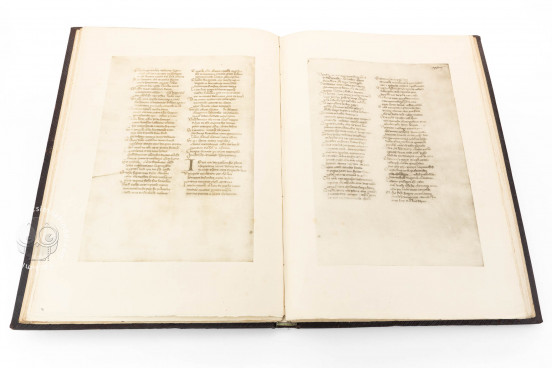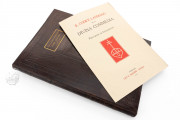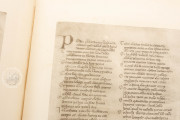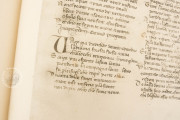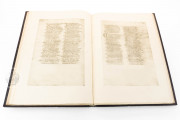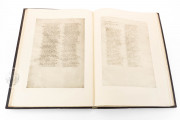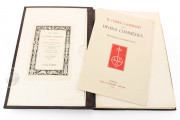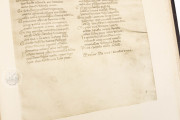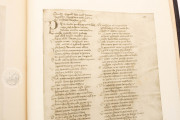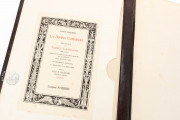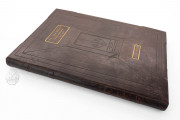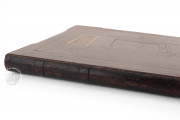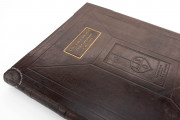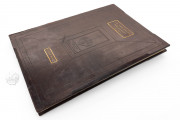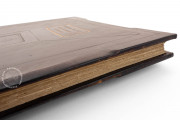The Landiano Manuscript of Dante's Divine Comedy is the earliest extant dated manuscript of the poet's masterpiece. A scribe identifying himself as Antonio da Fermo wrote the original text in 1336, just fifteen years after Dante's death. He copied the text in Genoa for Beccario de' Beccaria, the city's chief magistrate at the time. Although modest, the manuscript is important for its early date and because its text was systematically corrected.
Dante's long (14,233 lines) Christian moralizing poem is divided into three cantiche ("canticles"), a designation meant to evoke the Bible. Those canticles—Inferno, Purgatorio, and Paradiso—are, in turn, divided into canti ("songs") of varying lengths.
Dante's Pilgrimage
Dante's poem describes his journey, identified as having taken place in 1300, through nine circles of hell (in Inferno); seven terraces where souls purge themselves (in Purgatorio); and then into the earthly paradise, through the nine heavenly spheres and, finally, into the Empyrean (in Paradiso).
The poet is led through his pilgrimage first by the ancient Roman poet Virgil, then by Beatrice (a character from the poet's earlier Vita Nuova), and finally by the medieval theologian Saint Bernard of Clairvaux (d. 1153).
An Innocent Family Member?
Beccario may have commissioned the manuscript because a monk named Tesauro Beccario (d. 1258)—perhaps a relative—appears in the poem, albeit in hell, having been executed by popular acclaim for his alleged involvement in a conspiracy to return the papal faction to Florence. There was contemporary disagreement concerning Tesauro's guilt, and Beccario probably saw him as innocent. In the manuscript, however, there is no indication of particular interest at the mention of the Beccaria name (fol. 29v).
Ancillary Texts
In the Landiano Manuscript, Dante's masterpiece is preceded by short poems by Dante himself and Guittone d'Arezzo (d. 1294) and followed by guides in verse to the Divine Comedy by Bosone da Gubbio, explaining the allegory, and Dante's son Jacopo Alighieri, discussing the structure.
Intense Concern for the Poet's Intention
Antonio wrote the opening poems in long lines (a single column) and the Commedia and the commentaries in two columns in Gothic Cursiva. In the Commedia, a colored initial of red or blue and a short Latin rubric in red introduces each canto, and a majuscule touched with ocher and set into the margin opens each tercet.
Spaces were reserved for large initials that were never executed at the beginning of each of the three canticles. Not long after Antonio wrote his text, a second scribe made copious amendments, presumably having consulted another exemplar, which was judged more authoritative
A Handsome Colophon
Antonio wrote the Latin-language colophon at the conclusion of the Commedia in an elegant Documentary Script of elongated calligraphic letters (fol. 100v). He records little about himself but credits his patron as an imperial soldier, doctor of laws, and podestà of the city and district of Genoa.
From Genoa to Parma to Piacenza
In the eighteenth century, the manuscript was in Parma in the joint possession of Orazio Pincolini Carissimi (1635-1713) and Artaserse Baiardi (1676-1767). Ferdinando Landi (1778-1853) bought the codex in 1819 from Fiorenzo Zappieri. The municipality of Piacenza purchased Landi's collection in 1872. The green leather binding with gilt tooling dates from the nineteenth century.
We have 1 facsimile edition of the manuscript "Divine Comedy - Landiano Manuscript": Codice Landiano della Divina Commedia facsimile edition, published by Leo S. Olschki, 1921
Request Info / Price
